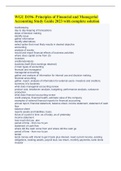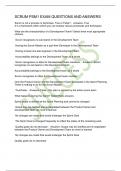Exam (elaborations)
WGU D196- Principles of Financial and Managerial Accounting Study Guide 2023 with complete solution
- Course
- Institution
WGU D196- Principles of Financial and Managerial Accounting Study Guide 2023 with complete solution bookkeeping day to day keeping of transcations steps of decision making identify issue gather information identify alternatives select option that most likely results in desired objective a...
[Show more]




